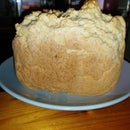Introduction: Flood Lamp LED Conversion - LED CHIP and PSU KIT.
I have a 100 watt work flood lamp, that used an old fashion halogen globe, and chewed through the power when I used it.
I thought, time for an upgrade.
Why upgrade and not buy a new lamp? Well, yes the new LED Worklights are cheap, but, lots of them are not outputting the advertised rating. Most are 20% to 30% underpowered relative to their advertised rated power output. Plus, why waste a perfectly good lamp case and I do like to make things. For all these reasons, I decided on an upgrade. And as I like to say. " 'Cause I can."
With modern LED COB chips, a led upgrade was now a viable option. As these chips consume less power, and output more light than the halogen version, while consuming less power, I knew I just had to do it. So, I ordered a 50 watt LED chip and LED power supply unit from the land of making stuff, China. Come on down. The price was right.
Here is what I got.
One Power Supply Unit and one LED Cob chip.
Step 1: Striping and Adding
1. One of the first things I did was test the Chip and PSU. Both tested ok, so it was on with the next stage.
Why test the bits first? Well, no good wasting time starting a build if your parts do not work. If you do, you will just have bits lying around waiting to be put together while you wait for replacements, and lose bits have a habit of getting lost. Better to have it all on hand in the first place, if at all possible.
Experience is a great teacher.
Experience from making mistakes like that, more so!
Step 2: Gutted and Cut
Now, to strip down the old lamp.
1. Firstly remove the original globe. Obvious, but it really is the first step. You can keep it for another project. Or a spare for any old spot lights not yet converted.
2. Start by removing the reflector. This is one piece at this stage. As you can see in the above photo, I have cut it into 4 pieces.
3. Next is to remove the lamp holder. These usually just simply unscrew with a regular screw driver. Save the bolts or screws and the washers. This can be reused, if not here, for another project.
Good rule, save it all!
3. The now the case is stripped and empty. The mounting holes at the bottom will be used to attach a heatsink.
The PSU, the gold coloured box seen in the third and fourth photo, is attached to the back with bolts passed through the end clips, and through holes I had drilled into the back of the yellow lamp assembly. I passed all the wires into the original black wiring box that is left on the back of the lamp.
Next the reflector was stripped and cut to allow the LED Chip and Heatsink to fit. As you will see on the next page.
Step 3: COB That LED.
LED Cob chips generate a lot of heat. So a good heat sink to remove that heat is required. They do not waste as much energy as an old fashioned globe in heat, but they still do require cooling for the heat that they do generate. All electronics generate heat. Just the amount varies.
Now, I didn't use the case as a heat sink because of a few reasons.
For one, I wanted the case to be cool to the touch as possible, as I tend to move the lamp around a lot when working on outside projects.
Two. The case was not flat or smooth enough to mount the chip directly. I could have put a shim metal piece at the bottom or grind it flatter, but this also would not do what I wished.
Three. I usually have lots of old computer/tv/radio parts lying around, including heatsinks. I had one that I knew would be about the right size, and have the right amount of heat dissipation, and put the chip in a raised position at a central focal point for the reflector. I do have a focusing LED Cob lense, but it seemed in testing prior, and after, to reduce the quality of the light coverage.
So.... enter an old Pentium II heatsink. All it took was cutting a few cm's off the back fins to fit the lamp case, and the addition of a few mounting holes. I hunted around my spare screws and nuts pile to find just the right, well, near enough, screws to mount the chip, and mount the heatsink into the case. Viola!
You can easily buy a new heat sink, or use some aluminium from a scrap yard, electronics parts store, computer store, or hardware store. Just get one with fins, and big enough for the LED and small enough for the case.
Regular 2.5mm x 15mm bolt and nut sets from your hardware store are used in this project. I you have none lying around, go get some! They are great use in a lot of DIY projects. Worth having a few around.
Step 4: It Puts the Heatsink in or It Gets the Hose Again
1. Before I mounted the LED chip on the heatsink (see prior step), I put some heatsink paste on the back first. This allows for a better heat transfer between the two surfaces, as there are always imperfections and minor warpages during usage, due to heat that reduces the surface contact area. You can pick this up from nearly every computer store (excluding the big white goods retailers) or electronics parts store.
More area contact, better transfer, cooler device, longer life.
2. Now, I am ready to add the chip/heatsink into the case. I screwed it to the existing mound holes on the bottom of the case, with some long screws. Then I attached the wires from the PSU to the tabs on each side of the chip.
In this shot, I have a focusing lense on. In the final version, I use the lamp without the lense. Seemed to work better.
3. Next, is inserting the reflector panels, which I cut to fit to the new height of the lamp (LED Chip), and I cut a channel for the wires to exit out of.
These reflector panel parts are simply held in place with hot glue holding them to the lip of the case.
4. Here is the Power Supply Unit (PSU) mounted on the back of the lamp case.
It is held in place with two mounting screws at each end and some hot glue, and the screw mount points are open and pressure hold only. The glue gives added stability and some heat transfer to the case, acting as a low heat, heatsink. This keeps the PSU cool, but does not overheat the case, still keeping it cool to the touch.
Note the wires going into the original terminal point, the black box next to the golden PSU. Extra heat shrink tubing will be added to cover the wires for extra protection and safety.
Here also, you can see the front grill is put back on while I tested it.
Step 5: All Is One With the Lamp
And let's see how it looks put together.
Here it is, all put back together, on the stand, and without the focusing lense.
Step 6: Let There Be Light!
And now, the money shot!
As you can see, the light is a fairly focus light and quite bright. Though the camera does not really capture it, the areas lite, are very bright and in sharp focus, due the spot like nature of the work light. You can see the contrast in the dark area's that are not lite by the light, compared to the lite areas.
The dark areas are very dark as there is little light spillage, with most of the light going to where it is pointed. The light is un-defused, very focused on one particular area where it is pointed. All this is without the focusing lense. Exactly what you want in a work light. Just your work being lite and in focus.
That is all folks. Hope you enjoyed my simple, easy conversion. Most of the work is down for you with a LED Chip and PSU kit. Just have to remember to use the 12 volt side to put the Red (Positive) wire, to the + symbol on the chip, and the Blue or Black (Negative) wire on the - symbol on the chip. The other side goes to your mains outlet. Could not be simpler!
Get converting and enjoy your well lite work spaces.

Participated in the
Lamps and Lighting Contest 2016

Participated in the
Backyard Contest 2016













